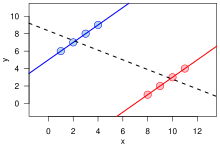Nghịch lý Simpson

Nghịch lý Simpson hay hiệu ứng Yule–Simpson, là một nghịch lý trong xác suất và thống kê, trong đó một xu hướng xuất hiện trong nhiều nhóm của dữ liệu nhưng biến mất hoặc đảo ngược khi các nhóm đó được gộp lại nếu là thứ khác. Nó đôi khi được gọi bằng nghịch lý đảo ngược hay nghịch lý gộp.[1]
Kết quả này thường gặp trong các thống kê của khoa học xã hội và y tế,[2] và gây hiểu lầm đặc khi dữ liệu tần suất được diễn giải như là nhân quả một cách biệt and is particularly confounding when frequency không phù hợp.[3] Những yếu tố nghịch lý biến mất khi quan hệ nhân quả được xét tới. Nhiều nhà thống kê tin rằng công chúng cần được thông tin về các kết quả phản trực quan trọng thống kê như nghịch lý Simpson.[4][5]
Edward H. Simpson mô tả hiện tượng này lần đầu tiên trong một bài báo kỹ thuật năm 1951,[6] nhưng các nhà thống kê Karl Pearson, et al., năm 1899,[7] và Udny Yule, năm 1903, đã nhắc đến hiện tượng tương tự trước đó.[8] Cái tên Nghịch lý Simpson được đưa ra bởi Colin R. Blyth năm 1972.[9]
Tham khảo
- ^ I. J. Good, Y. Mittal (tháng 6 năm 1987). “The Amalgamation and Geometry of Two-by-Two Contingency Tables”. The Annals of Statistics. 15 (2): 694–711. doi:10.1214/aos/1176350369. ISSN 0090-5364. JSTOR 2241334.
- ^ Clifford H. Wagner (tháng 2 năm 1982). “Simpson's Paradox in Real Life”. The American Statistician. 36 (1): 46–48. doi:10.2307/2684093. JSTOR 2684093.
- ^ Judea Pearl. Causality: Models, Reasoning, and Inference, Cambridge University Press (2000, 2nd edition 2009). ISBN 0-521-77362-8.
- ^ Robert L. Wardrop (February 1995). "Simpson's Paradox and the Hot Hand in Basketball". The American Statistician, 49 (1): pp. 24–28.
- ^ Alan Agresti (2002). "Categorical Data Analysis" (Second edition). John Wiley and Sons ISBN 0-471-36093-7
- ^ Simpson, Edward H. (1951). “The Interpretation of Interaction in Contingency Tables”. Journal of the Royal Statistical Society, Series B. 13: 238–241.
- ^ Pearson, Karl; Lee, Alice; Bramley-Moore, Lesley (1899). “Genetic (reproductive) selection: Inheritance of fertility in man, and of fecundity in thoroughbred racehorses”. Philosophical Transactions of the Royal Society A. 192: 257–330. doi:10.1098/rsta.1899.0006.
- ^ G. U. Yule (1903). “Notes on the Theory of Association of Attributes in Statistics”. Biometrika. 2 (2): 121–134. doi:10.1093/biomet/2.2.121.
- ^ Colin R. Blyth (tháng 6 năm 1972). “On Simpson's Paradox and the Sure-Thing Principle”. Journal of the American Statistical Association. 67 (338): 364–366. doi:10.2307/2284382. JSTOR 2284382.
Bibliography
- Leila Schneps và Coralie Colmez, Math on trial. How numbers get used and abused in the courtroom, Basic Books, 2013. ISBN 978-0-465-03292-1. (Sixth chapter: "Math error number 6: Simpson's paradox. The Berkeley sex bias case: discrimination detection").
Liên kết ngoài
- Cẩn thận với con số phần trăm! - Nguyễn Văn Tuấn[liên kết hỏng]. Kinh tế Sài Gòn online. 22 tháng 6 năm 2010.
- How statistics can be misleading - Mark Liddell—TED-Ed video and lesson.
- Stanford Encyclopedia of Philosophy: "Simpson's Paradox" – by Gary Malinas.
- Earliest known uses of some of the words of mathematics: S
- For a brief history of the origins of the paradox see the entries "Simpson's Paradox" and "Spurious Correlation"
- Pearl, Judea, ""The Art and Science of Cause and Effect." A slide show and tutorial lecture.
- Pearl, Judea, "Simpson's Paradox: An Anatomy" (PDF)
- Simpson's Paradox Visualized - an interactive demonstration of Simpson's paradox.
- Short articles by Alexander Bogomolny at cut-the-knot:
- "Mediant Fractions."
- "Simpson's Paradox."
- The Wall Street Journal column "The Numbers Guy" for ngày 2 tháng 12 năm 2009 dealt with recent instances of Simpson's paradox in the news. Notably a Simpson's paradox in the comparison of unemployment rates of the 2009 recession with the 1983 recession, by Cari Tuna (substituting for regular columnist Carl Bialik).














